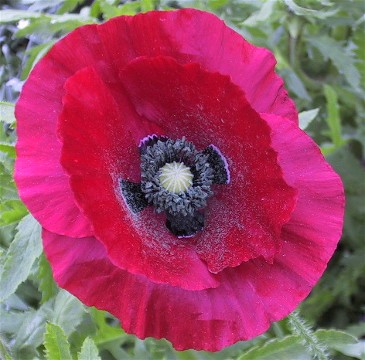

So, what’s NOT beneficial about flowers? I mean, aren’t flowers the things that stir our souls to write poetry? Don’t their colors lift our spirits on a gray day? Don’t they sometimes get us out of the doghouse? You may have heard about the idea to create a Beneficial Flower Bed in the garden, one that would grow flowers intended to benefit our vegetable plantings.
In the early spring we set aside a bed about midway down the east side of the garden, with the plan to seed it with those flowers known to have these beneficial qualities -- ones that would attract the nectar- and pollen-collecting bees that pollinate our crops as a sideline while gathering their own food, as well as insects that feed on the eggs or larval forms of the many moths, flies, mites and aphids that can infest our plants.
The garden has had only a passing interest in flowers until last season. Then a group of enthusiasts began to expand these plantings, partly for the aesthetic appeal that they provide, but also with increasing knowledge from agricultural experts on the benefits of having a more diverse culture of plants, thus attracting insects that could help us avoid the use of pesticides in our striving to be organic.
Unfortunately, due to the vagaries of our screwy spring weather this year, that bed has not yet prospered. The molds and worms won the battle, defeating the germinating of most of the seeds planted there. But new seedlings of cilantro and dill are starting to come up, and will add some benefits as well as season our pickles and salsas later this summer.
In past years we’ve had heavy infestations of diabolical diabroticas by this time and, sure enough, they are starting to show up again. One striking example of their damage can be seen at the top of the garden where the dahlias are planted. On close inspection, you can see the damage these black-spotted, yellow-bellied “cucumber beetles” have done to these flowers. And in past years I’ve noticed large concentrations of them on the volunteer yellow dahlias that grew along our western fence. Could it be that dahlias are our best lure for these pests, keeping them from moving on to our own food crops? Dahlias may be our sacrificial beneficial flowers.
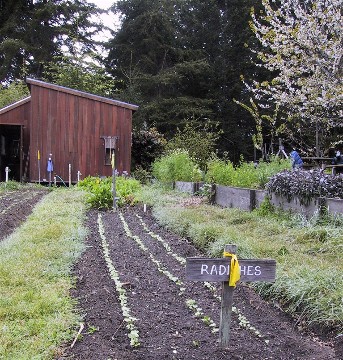
John Horn, our watering guru, sends an urgent reminder to all waterers regarding the meaning of YELLOW FLAGS on the beds and YELLOW LINES on the weekly watering sheets. Water, all Gardeners know, is the life of the Garden. An essential art of gardening is bringing water consistently and in the right amount -- not too much, not too little -- to the growing things.
John’s message is mainly addressed to weekend waterers, but is for all waterers... all Gardeners... as well. John sent an email to the Steering Committee, which TCH now passes along, slightly edited. He notes discrepancies and confusions about the meaning of the yellow flags and yellow lines, and goes on to point out good-for-the-Garden watering practices.
The yellow lines on the Watering Sheet, which lives on the clipboard hung inside the shed door, indicate which beds bear yellow flags. A yellow flag means seeds are germinating in a newly-planted bed, or that seedlings or plants newly transplanted from the greenhouse are just getting established. A yellow flag bed’s soil should always be damp. Frequent and close checking is absolutely necessary. All Gardeners should keep an eye on yellow flag beds and alert the day leader to conditions requiring attention. Also, as of now, only Saturday and Sunday will be outlined in yellow.
Yellow flags are removed once the plants have established a root system large enough to safely stand several days (like a weekend) without water. Just when the yellow flag should be removed depends on the particular crop. The day leader decides. Gardeners should alert day leaders, too, when it appears that a yellow flag could be removed.
Weekend waterers routinely water ONLY the beds with yellow flags, which, again, are indicated by yellow lines on the watering sheet. When the Garden is up and growing, weekend waterers should need to water only yellow flagged or lined beds, which should make their job a lot more do-able.
But, also as a matter of routine, weekend waterers must check each bed each day of the weekend and enter the appropriate symbol on the Watering Sheet. Each bed should be checked BEFORE watering. Waterers… all waterers... should not rely on just looking at the bed. Because of the soil, wind, temperature, humidity, and the crop itself, a bed can look damp and be dry down below, or look dry on top and be wet down below at the root zone. Use the probe tool, which hangs in the shed, to test the soil for dampness using the compression technique: if the plug crumbles, the soil is too dry. Probe several inches deep in at least three places in a bed.
Water well and see the Garden thrive.
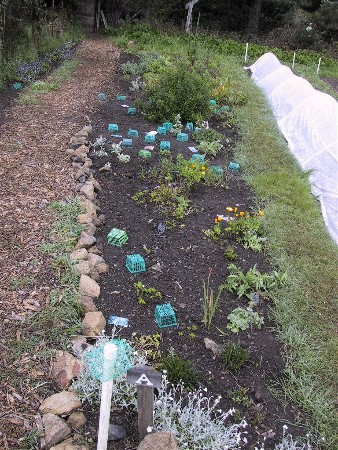
Poison oak has been spotted on the south side of the wire fence between the Garden and the parking lot. Not in the Garden, thankfully.
That three-cubic-yard pile of good stuff up by the shed looms large to the eye, but is (almost) undetectable to the nose. Tom Warnock, Dick Borg and John Horn, with truck and trailer, made an early morning run to Stornetta’s in Point Arena and came back with three yards of well-composted and aged steer manure. Cost: $60. The manure will be an important ingredient in the compost, and is an excellent soil amendment. It is not so good for mulching, however, and doesn’t have much oomph as a fertilizer, contrary to appearance.
The Committee adopted a design for the trellis and would like to get construction underway. Of redwood, it will rise 8’ high over the bench in a simple, straightforward manner. It will be 9’ wide and 5’ deep, and make a kind of Maybeck gesture. Flowering vines will climb and canopy the trellis, season after season, depicting in their own renewal the continuity of the Garden spirit and its Gardeners, past and present. Actually, the platform, the bench and the trellis will be an embracing, whole-Garden kind of memorial monument. Already, there are three memorial plaques on the bench, with room for many more. Construction will begin when sufficient funds are on hand. About $400 more is needed to make up the estimated $700 cost for materials. Donations are invited. Make your check out to “Posh Squash” and give it to Tom, Mary or your day leader. Check with Ben if you want to help build it.
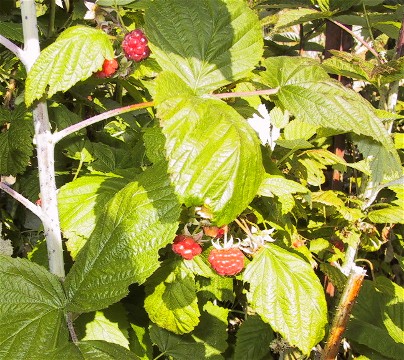
The Posh Squash is rich in raspberry vines: five rows, each about a hundred feet long. But proper watering has always been a problem; that is, enough water at the right times. Now, thanks to Ben Klagenberg and his crew -- Bruce Leibrock, John Horn, Jim Grenwelge, Debbie Hoyt, Bob Coleman, George Haas, Derek Bray, and others -- a whole new irrigation system is installed and in the process of being broken in and tuned up.
The system is supplied by a 1-inch water line, and has its own shut-off valve at the southwest, uphill corner. Three manifolds, each with its own valve, distribute water to three sets of dripper hose. Each set has ten lines of dripper hose. When the system is on, water pressure elsewhere will diminish, but not too much. Waterers will need to observe just how many lines they can open to other beds and still have enough water pressure.
It was a big job. New wires to support the vines, and new posts to support the wires. Ben listed the materials used: 1200 feet of 1/2-inch plastic dripper hose with about 1000 laser-pierced emitters; 60 feet of ¾-inch PVC; 30 tees; 6 elbows, 33 hose connections, a lot of valves. And a can of glue. About $700 worth of the materials was donated, thanks to Bruce Leibrock. Other materials cost about $150. And a lot of hard work. Our rocky soil yields grudgingly to post holes and trenches.
Pondering on how to get the most out of the new water system, the Committee decided to leave it turned on. Thus, whenever the MAIN VALVE is opened for daily and weekend watering, the raspberries will get water. But slowly; these high-tech (laser-pierced) drippers drip mighty slow.
Go take a look and check out this ingenious, well-designed and well-made system. And dream about riches upon riches of raspberries.

Short hours, challenging yet easy work, huge rewards. Anyone for Treasurer? Let Tom or Mary know.
Our supply of pruning clippers has disappeared. Anybody seen our missing clippers? Anybody got a spare pair to donate?
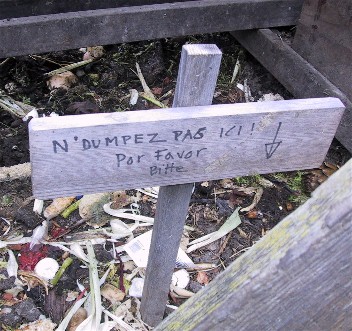
The Steering Committee met under the cherry tree at the Garden on Friday, June 20, 2003. Present were Tom Warnock, Mary Austin, Ken Holmes, Sal Skibbins, Jer Skibbins, Dianne Rasmussen, Ralph Rasmussen, John Horn, Ben Klagenberg, MA Brauer, and your faithful scribe, Chester Case. Charles Shaw was a welcome guest. For two hours, the Gardeners discussed a wide range of matters, from essential minutia to long-range plans and projects. A strong wind gusted across the Garden, stirring leaves and drying the soil.
A moment was taken to comment on the summer solstice. According to the dictionary, a solstice (summer or winter) is when the sun, having reached its farthest point from the Equator, “appears to stand still.” Ah, nothing stands still in a good Garden! A major implication is the shortening of days and corresponding changes in growing conditions. At solstice, the Gardeners judged, the Garden is doing well. Summer planting is almost accomplished, and some crops already harvested need to be replanted. Plans for winter planting are in the works. The Garden is in good shape, it was agreed. There is the persistent problem of choreographing bed preparation and planting according to plan. Too many (eleven) beds unplanted at the moment, agreed; but unfavorable (for planting) weather and insects had their unhelpful ways with our careful plans. The greenhouse is sprouting prodigiously, but there is that maybe-never-to-be-completely-overcome slippage between propagation and planting. Since weather, insects and other natural events deflect the Gardeners’ plans, the problem is likely to be with us always, though diligence can mitigate it.
Tom told the Committee that negotiations with the Baker Estate are continuing in a positive vein, but there is no new news to relate.
The Committee heard reports on the newly upgraded raspberry watering system and approved a design for the Doris Buck Memorial Trellis. Look for stories on these and the new heap of manure in this issue of The Compost Heap.
Noteworthy items: Poison oak has been seen on the parking lot side of the wire fence on the south end. All our pruning clippers are missing and need replacing. Signs identifying crops will be repaired and new ones made, along with the hose storage racks. Crowding between the raised beds and the greenhouse cold frames will be lessened by moving the cold frames. A float will be installed in the greenhouse water tank to automatically refill it, and chlorine in small amounts will be introduced to head off the algae and bacteria that are hampering propagation.
For further information, contact Tom, Mary or your day leader.
|
Skim ocean meadows What acrobats! |
Garden Haiku by Gerry Wilson